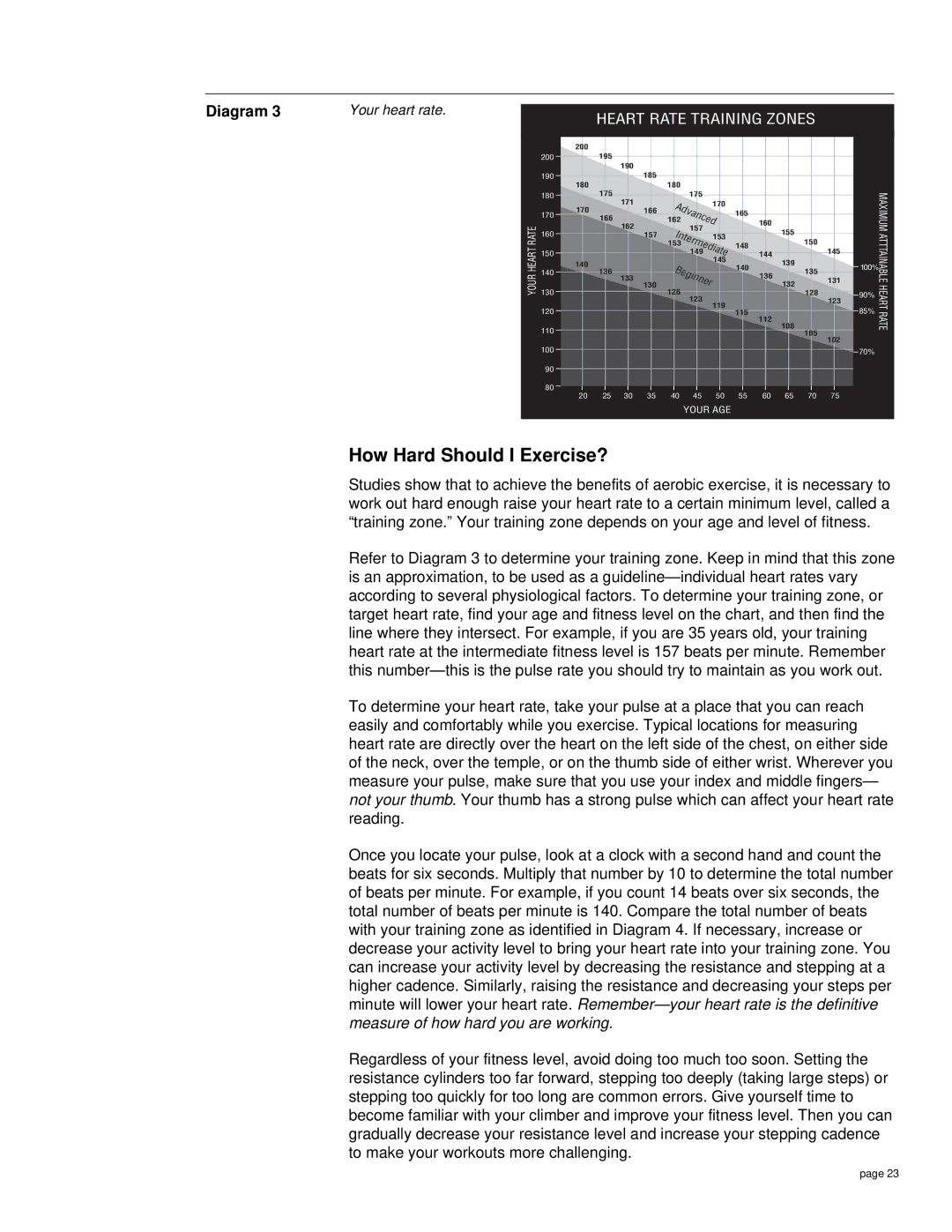
Diagram 3 | Your heart rate. |
|
| HEART RATE TRAINING ZONES |
| ||||||||||
|
|
|
|
| |||||||||||
|
|
| 200 |
|
|
|
|
|
|
|
|
|
|
|
|
|
| 200 |
| 195 | 190 |
|
|
|
|
|
|
|
|
|
|
|
|
|
|
|
|
|
|
|
|
|
|
|
|
| |
|
| 190 | 180 | 175 |
| 185 | 180 |
|
|
|
|
|
|
| |
|
|
|
|
|
|
|
|
|
|
|
| ||||
|
| 180 |
| 171 |
|
|
| 175 | 170 |
|
|
|
|
| |
|
|
| 166 |
|
|
|
|
|
|
|
| ||||
|
|
|
|
|
|
|
|
|
|
|
|
| |||
|
| 170 | 170 |
| 166 | 162Advanced | 165 |
|
|
|
| ||||
| RATE |
|
| 162 |
|
|
| 157 |
| 160 |
|
|
| ||
|
|
|
|
|
|
|
|
|
|
|
| ||||
|
|
|
|
| 153 |
|
|
|
| 150 |
| ||||
|
| 150 |
|
|
| 157 |
| Intermediate |
| 144 | 155 |
|
| ||
|
| 160 |
|
|
|
|
|
| 153 | 148 |
|
|
|
| |
| HEART |
| 140 |
|
|
|
|
| 149 |
|
| 139 |
| 145 | |
|
|
|
|
|
|
| 145 | 140 |
|
| |||||
|
|
|
|
|
|
|
|
|
|
|
|
| |||
|
|
|
|
|
|
|
| Beginner |
|
|
|
|
| ||
| YOUR | 140 |
| 136 | 133 | 130 |
|
|
| 136 | 132 | 135 | 131 | ||
|
| 126 |
|
|
| ||||||||||
| 130 |
|
|
|
|
| 128 | ||||||||
|
|
|
|
|
|
|
|
| |||||||
|
|
|
|
|
|
|
|
| 123 | 119 |
|
|
|
| 123 |
|
| 120 |
|
|
|
|
|
|
| 115 |
|
|
|
| |
|
|
|
|
|
|
|
|
|
| 112 | 108 |
|
| ||
|
|
|
|
|
|
|
|
|
|
|
|
|
| ||
|
| 110 |
|
|
|
|
|
|
|
|
|
|
|
| |
|
|
|
|
|
|
|
|
|
|
|
|
| 105 | 102 | |
|
|
|
|
|
|
|
|
|
|
|
|
|
|
| |
|
| 100 |
|
|
|
|
|
|
|
|
|
|
|
|
|
|
|
|
|
|
|
|
|
|
|
|
|
|
|
| |
|
| 90 |
|
|
|
|
|
|
|
|
|
|
|
|
|
|
|
|
|
|
|
|
|
|
|
|
|
|
|
| |
|
| 80 | 20 | 25 | 30 | 35 | 40 | 45 | 50 | 55 | 60 | 65 | 70 | 75 | |
|
|
| |||||||||||||
YOUR AGE
How Hard Should I Exercise?
100%
90%
85%
70%
MAXIMUM ATTTAINABLE HEART RATE
Studies show that to achieve the benefits of aerobic exercise, it is necessary to work out hard enough raise your heart rate to a certain minimum level, called a “training zone.” Your training zone depends on your age and level of fitness.
Refer to Diagram 3 to determine your training zone. Keep in mind that this zone is an approximation, to be used as a
To determine your heart rate, take your pulse at a place that you can reach easily and comfortably while you exercise. Typical locations for measuring heart rate are directly over the heart on the left side of the chest, on either side of the neck, over the temple, or on the thumb side of either wrist. Wherever you measure your pulse, make sure that you use your index and middle fingers— not your thumb. Your thumb has a strong pulse which can affect your heart rate reading.
Once you locate your pulse, look at a clock with a second hand and count the beats for six seconds. Multiply that number by 10 to determine the total number of beats per minute. For example, if you count 14 beats over six seconds, the total number of beats per minute is 140. Compare the total number of beats with your training zone as identified in Diagram 4. If necessary, increase or decrease your activity level to bring your heart rate into your training zone. You can increase your activity level by decreasing the resistance and stepping at a higher cadence. Similarly, raising the resistance and decreasing your steps per minute will lower your heart rate.
Regardless of your fitness level, avoid doing too much too soon. Setting the resistance cylinders too far forward, stepping too deeply (taking large steps) or stepping too quickly for too long are common errors. Give yourself time to become familiar with your climber and improve your fitness level. Then you can gradually decrease your resistance level and increase your stepping cadence to make your workouts more challenging.
page 23
